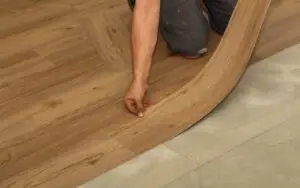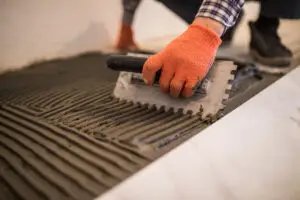Understanding the Costs of Wood Floor Refinishing
Key Factors Influencing Refinishing Costs
Type of Wood
The type of wood flooring you have is one of the primary factors that influences the cost of refinishing. Some hardwoods are denser and more difficult to sand, while others may require specific types of finishes. Exotic hardwoods often require more specialized techniques and materials, which can increase both labor and material costs. Professional refinishers are very familiar with different types of wood, and will be able to give you an accurate estimate based on the type of wood that you have.
Size of the Area
The size of the area that needs refinishing is another key factor that will impact the overall cost. Larger areas will require more time and materials, and will therefore lead to higher costs, while smaller areas will often have lower costs. However, even with smaller areas, you should always hire a professional refinisher, as these types of projects often require a good deal of expertise, knowledge, and specialized tools.
Condition of the Floors
The condition of your wood floors will also significantly impact the cost of refinishing. If your floors have deep scratches, water damage, or significant wear, the refinishing process will require more time and effort, and will often cost more. Floors that require extensive repairs, may also require more sanding, or more coats of finish, which will increase the overall cost. Professional installers will always take these issues into consideration, and give you a transparent and accurate quote.
Average Cost of Wood Floor Refinishing
Cost per Square Foot
The average cost to sand down and refinish wood floors in the USA generally ranges from $3 to $8 per square foot. This cost includes both labor and material expenses, and is greatly affected by the factors mentioned above. Keep in mind that this is just an average, and it is important to get a detailed quote from a local professional installer for your specific needs.
Regional Differences
Refinishing costs can vary considerably based on your geographical location. Areas with a higher cost of living, and higher demand, will tend to have higher prices for both labor, and materials. It is always wise to do some research, and compare prices from local installers, before making your final decision.
Detailed Cost Breakdown
Sanding Costs
Equipment and Supplies
Sanding costs include the cost of renting or purchasing equipment such as drum sanders, orbital sanders, and edge sanders. It also includes the costs of all of the sandpaper needed, and other tools or supplies. These types of costs can quickly add up, especially for a DIY project, which is why it is often recommended to hire a professional, as they will already have all of these specialized tools.
Labor Costs
Labor costs for sanding will be affected by the size of the area, the type of wood, and the condition of the floors. More complicated projects with multiple levels, or unique patterns, may have slightly higher labor charges. Professional installers have the experience and knowledge to perform the sanding quickly, efficiently, and correctly, which will ultimately save you time, and money.
Refinishing Costs
Type of Finish
The cost of the finish depends on the type that is selected. Oil-based finishes are typically more affordable, but they also tend to have a stronger odor, and require more drying time. Water-based finishes are more environmentally friendly, and they dry faster, but they also tend to have a slightly higher price point. Professional refinishers will guide you in choosing the best type of finish for your specific needs.
Application Costs
The cost of application is based on the number of coats of finish that will be applied, and the complexity of the project. More complex projects, or those that require multiple coats of finish, will have higher labor costs. Professional refinishers always know how many coats are required to achieve the best, and most durable results.
Additional Costs to Consider
Repairs and Subfloor Preparation
Any necessary repairs to the wood flooring or subfloor will add to the total cost. Extensive repairs, or subfloor leveling, will take extra time and materials, and may increase the cost of the project. These types of issues are often missed by DIYers, but will always be noticed by professional installers.
Stain Selection
The selection of stain can also affect the cost. Some stains are more expensive, and require more coats for the desired color. Professional installers can help you choose a stain that fits both your budget, and your aesthetic goals. They are also familiar with the best practices for stain application, and will ensure that your new stain looks its best.
DIY vs Professional Wood Floor Refinishing
DIY Refinishing: Potential Savings and Risks
Tool and Equipment Costs
DIY refinishing projects often have hidden costs, such as the expense of renting or purchasing all of the required tools. These specialized tools can often be very expensive, and may not be worth the expense, especially if you only intend to use them once. In addition to the high initial cost, most homeowners do not know how to properly use these types of tools, which can lead to many errors, and costly rework.
Potential for Mistakes and Rework
DIY refinishing often comes with a high risk of making costly mistakes, that may require extensive rework, or could even ruin your floors completely. Improper sanding, an uneven stain application, or a poor finish, are all very common problems that DIYers encounter, and that professional installers are very well-trained to avoid. Professional services often offer peace of mind, that DIY projects simply cannot provide.
Professional Refinishing: Benefits and Advantages
Expertise and Efficiency
Professional wood floor refinishers bring expertise and efficiency to your project. They have all of the tools, skills, and techniques to complete the project quickly and correctly, with minimal interruption to your home. They are also trained in all of the latest best practices, and are up to date on all of the new products and techniques in the field.
Long-Term Value and Durability
Professional refinishing often provides better long-term value by ensuring a durable, long-lasting finish, and by preventing any potential damage to your floors. They are trained to ensure that the finish will be long-lasting and beautiful, and they will also provide a warranty to protect your investment. These types of benefits are not available with DIY projects.
Case Studies: DIY vs Professional Refinishing
Example of a Costly DIY Mistake
A homeowner attempted a DIY wood floor refinishing project to save money. However, they did not properly sand the floors, which resulted in an uneven surface. They also applied the stain unevenly, which made their floors look blotchy and unprofessional. In the end, they had to hire a professional to correct all of the mistakes and redo the job, costing them more money than if they had hired a professional in the first place.
Example of an Efficient Professional Job
Another homeowner hired a professional wood floor refinishing service. The professional installers properly sanded the floor, and applied the stain and finish with precision, resulting in a beautifully refinished floor that was durable, long lasting, and that increased the value of their home. This homeowner was extremely pleased with the high-quality work, and they greatly appreciated the peace of mind they received, knowing that all of the work was guaranteed.
FAQs & Answers
The average cost to sand and refinish wood floors in the USA ranges from $3 to $8 per square foot, depending on factors such as the type of wood, the size of the area, and the complexity of the job. While DIY refinishing may seem cheaper upfront, it often comes with hidden costs and potential for mistakes that professional services can avoid. Professional installers will always provide a high-quality finish, and have all of the right tools, techniques and knowledge to protect your investment.
The type of wood significantly affects the cost of refinishing, as some hardwoods are more difficult to sand and require specialized treatments and products. Exotic hardwoods and intricate patterns also tend to increase labor costs. Professional wood floor refinishing services will always provide an accurate quote and will help you choose the best type of finish for the type of wood that you have.
Other factors that can impact the cost include the condition of the floors, any required repairs, the type of finish selected, the desired color, and the complexity of the job. Professional refinishing services always account for all of these factors, and will provide a detailed and accurate quote that includes all expenses, without any hidden fees.
While DIY wood floor refinishing may appear to save money upfront, it often leads to costly mistakes such as uneven sanding, poor finish application, and other issues that require professional help to fix. Professional wood floor refinishing services have the expertise, tools, and techniques needed to ensure a high-quality and long-lasting result that is usually worth the extra expense. They also provide a warranty that is not available with DIY projects.
Professional wood floor refinishing services typically offer warranties that cover both the labor and the materials used. These warranties give you peace of mind, and protect your investment. They will ensure that any issues or problems that occur after the install, will be fixed at no extra expense to you. DIY projects do not offer any warranties, which makes professional services a much better choice.





